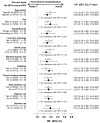Incident heart failure hospitalization and subsequent mortality in chronic heart failure: a propensity-matched study
- PMID: 18381184
- PMCID: PMC2771194
- DOI: 10.1016/j.cardfail.2007.12.001
Incident heart failure hospitalization and subsequent mortality in chronic heart failure: a propensity-matched study
Abstract
Objective: Hospitalization for worsening heart failure (HF) is common and associated with high mortality. However, the effect of incident HF hospitalization (compared with no HF hospitalization) on subsequent mortality has not been studied in a propensity-matched population of chronic HF patients.
Methods: In the Digitalis Investigation Group trial, 5501 patients had no HF hospitalizations (4512 alive at 2 years after randomization) and 1732 patients had HF hospitalizations during the first 2 years (1091 alive at 2 years). Propensity scores for incident HF hospitalization during the first 2 years after randomization were calculated for each patient and used to match 1057 patients (97%) who had 2-year HF hospitalization with 1057 patients who had no HF hospitalization. We used matched Cox regression analysis to estimate the effect of incident HF hospitalization during the first 2 years after randomization on post-2-year mortality.
Results: Compared with 153 deaths (rate, 420/10,000 person-years) in the no HF hospitalization group, 334 deaths (rate, 964/10,000 person-years) occurred in the HF hospitalization group (hazard ratio 2.49; 95% confidence interval 1.97-3.13; P < .0001). The hazard ratios (95% confidence intervals) for cardiovascular and HF mortality were 2.88 (2.23-3.74; P < .0001) and 5.22 (3.34-8.15; P < .0001), respectively.
Conclusions: Hospitalization for worsening HF was associated with increased risk of subsequent mortality in ambulatory patients with chronic HF. These results highlight the importance of HF hospitalization as a marker of disease progression and poor outcomes in chronic HF, reinforcing the need for prevention of HF hospitalizations and strategies to improve postdischarge outcomes.
Figures




References
-
- Rosamond W, Flegal K, Friday G, et al. Heart disease and stroke statistics--2007 update: a report from the American Heart Association Statistics Committee and Stroke Statistics Subcommittee. Circulation. 2007;115:e69–171. - PubMed
-
- Rich MW, Beckham V, Wittenberg C, Leven CL, Freedland KE, Carney RM. A multidisciplinary intervention to prevent the readmission of elderly patients with congestive heart failure. N Engl J Med. 1995;333:1190–1195. - PubMed
-
- Clinical Quality Improvement Network Investigators. Mortality risk and patterns of practice in 4606 acute care patients with congestive heart failure. The relative importance of age, sex, and medical therapy. Arch Intern Med. 1996;156:1669–1673. - PubMed
-
- Ahmed A, Allman RM, Kiefe CI, et al. Association of consultation between generalists and cardiologists with quality and outcomes of heart failure care. Am Heart J. 2003;145:1086–1093. - PubMed
-
- Fonarow GC, Yancy CW, Heywood JT. Adherence to heart failure quality-of-care indicators in US hospitals: analysis of the ADHERE Registry. Arch Intern Med. 2005;165:1469–1477. - PubMed
Publication types
MeSH terms
Grants and funding
LinkOut - more resources
Full Text Sources
Medical
Research Materials
Miscellaneous

